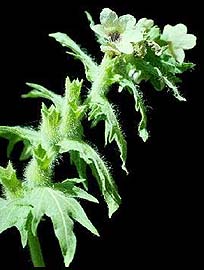Henbane, Black henbane
Hyoscyamus niger Henbane has the bad reputation of a plant that has poisoned and killed many people. The famous English playwright Shakespeare perpetuated this plant by putting a tincture of henbane in the hand King Hamletâs murderer. |
Henbane is a poisonous plant, well known since the remote past. It was used in ancient Babylon, Egypt, Persia, Greece and Rome. Henbane is a widely distributed weed in Europe, Asia, Africa and North America. It is a biennial grayish-green sticky plant with an unpleasant smell. It is amazing that henbane produces a huge amount of seedsâfrom 10,000 to half a million per plantâand as few as 10-20 are enough to poison a child. All parts of henbane are poisonous. They contain the same alkaloids â¢belladonnaâ¢does, namely: hyoscine, hyoscyamine, atropine, and scopolamine. In fact, henbane is less toxic than belladonna because the amount of its alkaloids is ten times as little. The poisoning effect of the plant rarely leads to death. In most cases, it causes a clinical condition, characterized by insanity, violence, seizures, trembling limbs and other symptoms similar to those caused by belladonna.
Hyosciamus niger
In the 13th and 14th centuries, it was revealed that the so-called witches had narcotized themselves by a special salve containing extracts of belladonna and henbane. If it was spread onto the skin, it caused vivid hallucinations of flying in the air, wild dancing and abundant feasts.Nowadays, henbane is cultivated as a source of alkaloids for the pharmaceutical industry. Drugs based on henbane alkaloids are applied in modern medicine as painkillers and antispasmodics.
Similar poisoning and healing effects are related to woody nightshade (Solanum nigrum) as well as climbing nightshade (Solanum dulcamara).

